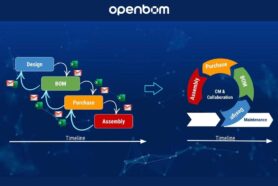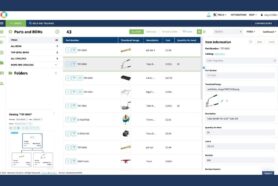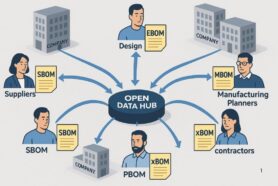
As manufacturers increasingly strive to be more agile, efficient, and cost-effective in their product development processes, finding ways to simplify collaboration between various teams across an organization has become a priority.
The reality of the engineering and manufacturing teams is to have many silos of information. It happens with SMBs and enterprises. For SMBs, you can see a variety of data pieces such as CAD design, BOM spreadsheets, financial software, cloud file storage, and emails to communicate with contractors in suppliers. Cloud CAD didn’t solve this problem, because at its best it created a cloud design system (eg. Onshape or Autodesk Fusion360), but the downstream path from that CAD design is still siloed and bumpy. You can see slightly different systems and details, but the same level of silos and disconnected information for enterprise companies – PDM/PLM/ERP/CRM/MES systems. This is a typical soup of enterprise three-letter acronyms, but the same outcome – companies and teams struggle to collaborate and communicate.
Why New Product Development Process?
As companies are looking at how to innovate, the New Product Development (NPD) process is always the top focus. Also, because it is one of the most important and also because it is one of the most complex. NPD involves multiple departments and specialists and it typically involves multiple steps: ideation, market research, design, prototyping, testing, and production. Each of these steps requires the input of various experts such as multiple engineers, marketers, and production specialists. Engineering is a super complex process, which requires multi-disciplinary design these days including mechanical, electronics, and software.
Collaboration between these engineers and departments is absolutely needed to ensure that the final product meets customer needs and can be manufactured efficiently. Additionally, collaboration allows for more efficient use of resources, better communication, and faster problem-solving. Only by working together, the development team can more effectively bring a new product to market. And this is a very complex thing because all existing legacy products are not built to collaborate in distributed teams and companies.
Any company that enables this new product development process to go faster will have an incredible level of competitive advantage in the market, but it requires bringing a product lifecycle management solution that is capable to perform product data management, business analysis, and inventory control as a single integrated process. And to move it fast!
OpenBOM Digital Thread For Collaboration
OpenBOM is a cloud-based platform that provides product lifecycle management PDM/PLM and ERP services for small and medium-sized businesses and for departments of large enterprises focusing on new product development (NPD). The key element of the OpenBOM platform is the “Digital Thread”, which helps to create a connected environment and refers to the continuous flow of data and information throughout the product lifecycle, from initial design and development to production, and even through to end-of-life disposal.
In the OpenBOM case, the extreme value of OpenBOM is connecting design, bill of materials, sourcing, and procurement in a single digital thread. OpenBOM provides a single source of truth for all product data, including design files, engineering drawings, bills of materials, and more. This helps eliminate silos of information and ensures that everyone involved in the product development process is working with the most up-to-date information.
OpenBOM Benefits In Details
Everything starts with seamless data access. OpenBOM Dashboard brings everyone on the same page in a single, search-driven, custom, and visual dashboard. It literally puts everyone on the same page (actually “BOM”) by bringing the information from multiple CAD systems (MCAD, ECAD, etc.) coordinating all purchasing and sourcing information, and managing the process of BOM collaboration and purchasing fast and seamlessly.
Here are the top 7 OpenBOM benefits:
- Collaboration: OpenBOM enables real-time collaboration between cross-functional teams, helping to improve communication and efficiency throughout the product development process between mechanical, electrical, and software engineers, connecting procurement and production planning (or connection to contract manufacturers)
- Data Management: OpenBOM provides a single source of truth for all product data (Items, catalogs, bill of materials /BOMs/, orders, and PO) together and helps to eliminate silos of information and ensures that everyone is working with the most up-to-date information.
- Cost Savings: OpenBOM helps businesses save time and reduce costs by automating manual processes and reducing the risk of errors and rework. Automatical capturing of data from CAD systems and transferring updates to finance and ERP – this is just a short list of benefits. OpenBOM automates the data creation process (eg. the creation of derivative files).
- Accessibility: OpenBOM is accessible from anywhere, at any time, via the cloud, making it easy for team members to access information and collaborate, regardless of location. Available via browser and easy-to-use instant data sharing. OpenBOM gives access to everyone at the same time. No one is consumed by multiple Excel files or emails.
- Customization: OpenBOM provides flexible customization options, allowing businesses to tailor the platform to meet their specific needs and requirements. Adding any attributes, files and other pieces of information is super easy.
- Integration: OpenBOM integrates with a variety of other software tools, such as CAD systems and project management platforms, allowing for seamless data exchange and improved workflows. Check more about OpenBOM Integrations.
- Security: OpenBOM uses industry-standard security measures to protect sensitive data and ensure that information is only accessible by authorized users. In fact, the cloud is more secure than on-premise platforms. Leading companies are recognizing the value of centralized security enforcement, which can be done in the best way by running OpenBOM solutions using industry-standard cloud services such as AWS.
How to Start Using OpenBOM and Customer Stories
To start using OpenBOM is super simple. Free registration with free 14 days trial will give you a foundation of OpenBOM knowledge combined with our training, online support, and help. Check out more details for the OpenBOM onboarding training program. Need to have inspiration about how to start using OpenBOM? Then check out OpenBOM customer stories and G2 reviews.
Conclusion:
OpenBOM offers a comprehensive and modern solution for cloud-based PDM and PLM with elements of ERP that greatly fits the needs of fast-growing new product development. Both small and large companies can use OpenBOM to streamline their product development process from initial ideation to procurement and assembly. It eliminates silos and helps to organize the data handover between teams and applications. OpenBOM also integrates with a variety of other software tools, such as CAD systems and other enterprise and SaaS platforms.
Additionally, its a customizable and accessible platform that provides flexible options and ensures that businesses can tailor the platform to meet their specific needs and requirements.
With unmatched cost-saving, flexible data management and integrations, OpenBOM is a valuable investment for businesses looking to streamline the product development process and make informed decisions based on real-time data. The platform provides an end-to-end solution for product lifecycle management, making it an ideal solution for businesses looking to improve collaboration and manage product data in the cloud.
You can REGISTER FOR FREE and check how OpenBOM can help you today.
Best, Oleg
Join our newsletter to receive a weekly portion of news, articles, and tips about OpenBOM and our community.










